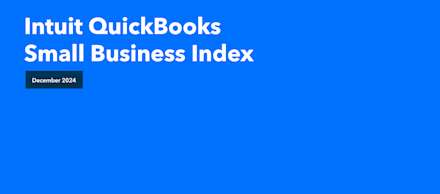
Intuit QuickBooks Small Business Index, December 2024
Simple, smart accounting software - no commitment, cancel anytime

STARTING YOUR OWN BUSINESS
Here’s a situation no business owner or freelancer wants to deal with: invoices way past their due date. You’ve provided the agreed-upon service or product. You’ve sent out an invoice. You’ve waited and waited, and now it’s been months since you sent out the original invoice. Do you charge your customer a late payment fee in addition to pursuing the outstanding balance?
One of the toughest decisions businesses have to make is how to approach past-due invoices. Freelancers and small business owners are particularly vulnerable to the negative effects of overdue payments.
Why? Because when you’re running a business, multiple late invoices can negatively impact your cash flow and ability to run your operations.
In this article we’ll explore when you might need to assess late charges, how to create a late payment charges policy, and how to encourage prompt payments.
A late payment fee is an extra charge levied against a client for not paying a bill by its agreed-upon due date. To charge for late payments, you must include payment terms within your original contract or sales agreement. In addition, when charging a client a late fee penalty, the invoice provided must list the due date and the late fee percentage or amount.
Business owners have the option to charge a flat rate or a monthly finance charge, usually a percentage of the overdue amount. Companies typically choose an appropriate rate of interest, or use the statutory interest rate. Either way, the amount should be stated in their payment terms.
To calculate the interest rate for a late fee, you’ll first need to decide on the annual interest rate. Once you have your annual interest rate, divide that by 12. This number will be your monthly rate. Then you’ll multiply the monthly rate by the amount due to get the monthly late fee charge.
Let’s look at an example:
You charge a 12% annual interest rate. A £12,000 project is overdue for payment by one month. To figure out the monthly finance charge, you’d multiply the outstanding £12,000 by the monthly interest rate (1% or .01). You’d arrive at a monthly finance charge of £120. The new outstanding balance would be equal to £12,120.
It is legal to charge late payment fees, but best practice is to explicitly state any interest on late payments within the contract.There are also regulations and laws regarding the amount a business owner can charge for a late payment fee, stated within the Late Payments Act.
There are a number of benefits to detailing late payment fees to your clients when sending an invoice or agreeing upon a contract, with late payment fees acting mainly as a deterrent for missing an invoice date.
Including a late payment fee in your invoice will deter clients from missing payment deadlines, and establish a healthy relationship where rendered services are paid for on-time. Your strongest business relationships will usually be with clients that do not miss payment deadlines, and vice versa.
Chasing a late payment will likely incur additional administrative fees, whether that is the costs of time and resources spent, or the additional problems caused by a disruption in cash flow - particularly for smaller businesses. Including a late payment fee will ensure that these additional costs are accounted for and paid by the client.
As a means of deterring missed payments, implementing late payment charges will allow you to more accurately predict the cash flow of your business, which will improve cash management and planning. Most companies will not be happy to pay a late payment fee, and as such,
Along with the positives of charging interest on late payments, there are also some negative points to consider relating to this practice. It is up to you or your business to decide which one outweighs the other.
There may be times when a usually reliable client may be unable to make a payment on-time. If this is an isolated incident, then charging interest on late payments to this type of client may negatively impact your working relationship. Clients that are usually reliable may expect some leniency if they fail to make a payment on time.
Chasing and collecting late payment fees, as well as adjusting budgets based on a reduced cash flow from late payments, will create an additional burden on your administrative team. Unless you have a client that regularly makes late payments, it is not usually easy to predict when your administrative staff will need to chase late payment fees, and this may take time away from other priority tasks.
If your company decides that implementing late payment fees does not suit their business model, then there are a number of alternatives for charging interest on overdue invoices in the UK.
In some cases, a customer might hit a financial rough patch and be unable to pay their invoice by its due date. Instead of charging a late fee, you can offer customers a payment plan.
Payment plans should clearly outline the minimum amount of payment required along with any interest rate charged for the outstanding balance. A customer can continue to make the minimum payments each month to avoid having a bill in collections.
If a customer regularly pays on time but doesn’t have enough money to pay one month, consider offering an extension to the next month. You can also implement extended payment terms in 60-, 90-, or 120-day time frames so customers have more time to pay in full.
Stating that customers can receive discounts by making their payments can be an effective measure for preventing late payments. Customers may feel inclined to access this discount by paying their invoices early, which may help negate late payments due to affordability.
Want to make sure your business is protected from delinquent accounts? Here’s our step-by-step guide for creating a late payment policy for your business.
Make sure the invoice lays out the details of late charges up front. It should also lay out the payment terms and the number of days the customer has to make the payment.
Include details like the invoice creation date, payment terms, total amount due with tax, product or service rendered, contact information, business name, and payment due date. Accounting software from QuickBooks can automate these details for you.
You can send an email invoice directly after the transaction occurs and a follow-up email if the bill goes unpaid after a certain period. A payment reminder should nudge the customer politely to call attention to the upcoming invoice obligation.
If a customer still has unpaid invoices, send another reminder with the late charge that details the total outstanding balance and give a deadline for payment. Depending on the circumstances and the relationship with the client, you might want to consider adding a warning that you will be forced to consider legal action if the overdue payment isn’t settled.
A debt going to a collection agency has serious consequences. It can lower a customer’s credit score and be a serious blemish on their credit history. As a result, the prospect of facing these consequences can prompt a customer to take the invoice seriously. Hopefully, though, your past-due invoices won’t get to this escalation point.
Everybody wants to be paid on time. But receiving late invoices is a problem that many businesses face. If you’re struggling to collect payments on time, consider changing your terms of payment or altering the late payment language on your invoices.
It’s also a good idea to use automated invoicing systems and accounting software like QuickBooks. Business owners can use QuickBooks to manage all invoices and track down missing payments more easily.
We hope you’ve found this article about advance billing helpful. Our guide to starting your own business in the UK can help you grow your business further - simply fill out the questionnaire to find out where you’re at in your business journey and what your next steps are.
The information on this website is provided free of charge and is intended to be helpful to a wide range of businesses. Because of its general nature the information cannot be taken as comprehensive and they do not constitute and should never be used as a substitute for legal, accounting, tax or professional advice. We cannot guarantee that the information applies to the individual circumstances of your business. Despite our best efforts it is possible that some information may be out of date. Any reliance you place on information found on this site or linked to on other websites will be at your own risk.
9.00am - 5.30pm Monday - Thursday
9.00am - 4.30pm Friday